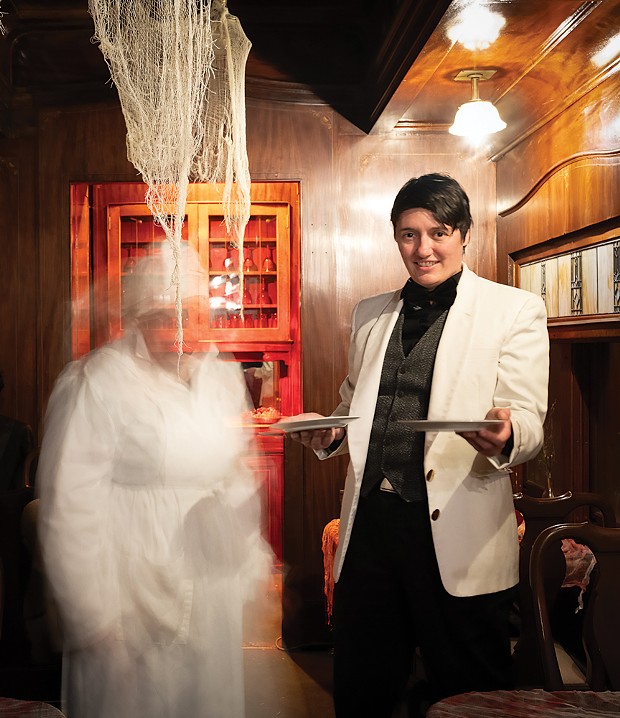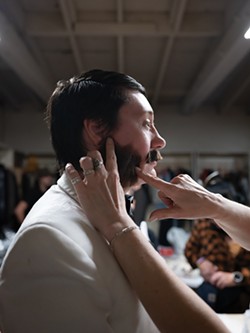Ghosts on the Tracks
All aboard the Haunted Rail Tour
By Jennifer Fumiko Cahill [email protected] @jfumikocahill[
{
"name": "Top Stories Video Pair",
"insertPoint": "15",
"component": "17087298",
"parentWrapperClass": "fdn-ads-inline-content-block",
"requiredCountToDisplay": "1"
}
]
A railyard at night is already a spooky place, and even more so with the fog that's settled on Samoa and the shoulders of the roundhouse, blurring the riveted and rust-streaked tops of 19th century train cars and tall steam donkeys. An open doorway offers a glimpse of old double-handled saws hanging on a wall. Inside the roundhouse shop, it smells of iron, dust and machine oil amid the hulking trucks and a behemoth black locomotive engine. A figure in black slips past, toward a lighted doorway.
There, leaning against the wall, stand a cast of cursed newlyweds, mourning ladies and creosote-smeared engineers, all awaiting their turn in the makeshift costume and makeup room. Tonight is the dress rehearsal for the Haunted Rail Tour, a joint fundraiser for North Coast Repertory Theatre, Timber Heritage Association and the Clarke Historical Museum, for which visitors will put down $15 to $20 for a stroll through a creepy night market of vendors, tortured spirits and gory hobos before entering the roundhouse full of eerie shadows, jump scares and menacing creatures. For another $5, a limited number of patrons can get the more intense experience in a trio of restored train cars.
Pre-COVID, the NCRT team haunted the Blue Ox Millworks for a couple of years. Back then, Chani Allen, executive director of the current production, started by filling in for an actor at the mill's "potions lab," then making masks and props, and even donning an "exhausting" monster suit with 18-inch leg stilts and arm stilts in front. "If it's fun," she says, "it doesn't matter how hard it is because it's fun." She recalls talk of moving to the Timber Heritage Association (THA) site in 2019 but then COVID hit.
THA President Sean Mitchell says back then, the organization was still in the process of remediation and Coastal Commission approval to purchase the Samoa property. The sale completed, the THA held a ribbon cutting in early 2023. "We're so lucky we were able to save these artifacts and that we have the roundhouse to store them," he says, noting that the Shay locomotives stored there are among only a few hundred left in existence, since rail companies were quick to scrap equipment that was no longer of use. "Some of these locomotives are so intrinsically valuable to our area that you almost can't put a price on them." Among the machines that serviced what was once the most profitable railroad line in the country are the No. 7 Annie and Mary, the Hammond No. 33 and No. 15, and the Pacific Lumber No. 29. The 1916 Pullman dining car that's part of the haunted tour, he says, was used to feed the 600-700 workers who rebuilt the railroad after the 1964 flood.
Making the tour safe for both the artifacts and the visitors took some doing. Mitchell says, "It's a historic industrial site; it doesn't exactly lend itself to people wandering around at night." Inviting visitors meant moving locomotives (no small task) to make room for wheelchairs and adding modular ramps for ADA accessibility, not to mention clearing paths of all potentially dangerous heavy-duty equipment.
Chani's husband Dax Allen marches toward the tracks in a top hat and a glittering red ringleader's jacket. Despite the aforementioned safety accommodations, he says the THA site required less building and set work than the working mill they'd used previously, leaving room in the budget for supplies and animatronics without cutting into profits. For three organizations that had to cancel staple fundraising events during the pandemic, every penny counts. The Clarke Museum, particularly its executive director Josh Buck, who's also a THA board member, has lent aid with finding sponsorships, coordinating night market vendors and publicity for the event. So far, Dax says, advance ticket sales have covered expenses, so whatever else comes in is profit to be split four ways, with each organization taking their cut and the fourth share banked for next year's event.
For a good haunting, the historic atmosphere and lonely, haunted vibes of the THA site are priceless, Dax says. The former Hammond Lumber Co. property and its circa 1890s roundhouse, the oldest in the U.S., are filled with the engines and cars that once carried redwood lumber, the ghosts of another time and all the industry's ingenuity and devastation. The brass and mahogany of the passenger cars whisper of lost luxury, while the actors employ a spare attached kitchen with metal paneling to macabre effect.
Mitchell, who has fond memories of the Haunted 1091 Ghost Ship Tour in 2013, likes the pairing of trains and ghosts, and hopes the event can continue. "When you're in ... any of these old buildings, it's so much more authentic ... you feel the weight of history and it makes the whole thing that much more eerie," he says. "You think about the people who were there before us." While he hasn't witnessed any paranormal activity on the THA property himself, others have come searching for ghosts. "When you go over there, especially at night, and you hear the wind creaking through the porous doors ... I think if there's anywhere to believe in ghosts, it's the Samoa roundhouse shops."
With the mood already set, the challenge, says Dean Windchester, director for the roundhouse tour, is filling such a big space with practical effects. Instead of relying on projections and high-tech effects, "everything that we're using are things that you would see from, like, an old grind horror movie from the '70s or '80s," he says. Aside from a few Bluetooth speakers, which can get a little glitchy surrounded by all the metal in the roundhouse, "Everything is human." Depending on the night, 40 to 65 of those humans are working in public view and behind the scenes, all unpaid volunteers but for the handful of Cal Poly Humboldt students receiving a stipend for their volunteer hours.
Actor A.J. Hempstead, looking dapper in a bow tie and wide-brimmed hat, plays a possessed groom. "It's a perpetual Purgatory of romance and pain," he says with a grin. Active in local theater, he heard about the event from director Jordan Dobbins, who's in charge of the train car tour, and thought it sounded fun. Once on site, "I fell in love with that historic train," he says. While largely improvised, the tour is built around a plot involving damned souls and passengers in peril. "Seeing the narrative come to life and seeing the response from the community has been incredible," he says, noting it's also a different experience than performing a play in a theater. "When you're on stage, the audience is expecting to have a relationship with you and expects that relationship to be one way." And when that relationship takes a turn, "They don't see that coming."
A wild head of black hair shadows Myrrh Adams' face. "I'm like the mother of the spirits," Adams says, fingers brushing an unblemished voodoo doll they brought from home. A burlesque performer with Tortured Angels Revue, they're accustomed to storytelling with movement and costume, and have enjoyed branching out with the workshops and being around the trains at the THA site. "And now it's all coming to fruition."
Inside the makeup and costume room, Ryann Citro sits in a bridal gown as Betsy Woods touches up a gash across her throat with a makeup brush. There are other brides, too, and white tulle and lace bloom from the open closet rack along with conductor uniforms and overalls.
As Dobbins passes, actor Sean Chapman, clad in dusty overalls, catches him and holds up a heavy handful of clinking iron, warning, "These are the shackles I told you about. The key is on there. You don't wanna' lose the key."
Beside them, Jaye Templeton is having their mustache and tufty mutton chops applied. No stranger to haunted houses, they say they've been dressing up and scaring visitors with their brother since elementary school. This is the first time back to it in a decade, and they're excited to haunt the dining car.
Amid the bustle, head makeup artist Natasha Mariani captains a table covered in brushes and palettes, a stack of more than 40 characters' face charts noting how each actor should look — what ghastly skin tone, what scars, what products to achieve it — and Ziploc bags with applicators and tools for each one. On her belt are tools and hair clips, a pack of wipes. She mixes makeup, cutting and smearing it with a palette knife, while calling out orders to the troops, catching a new artist up on protocol and deploying them to a new face.
A professionally trained makeup artist, Mariani says the freelancing she does for weddings and photo shoots, theater and film, as well as the annual Zombie Walk, aren't enough to make a living, but she still enjoys it. Especially the Halloween stuff. "I like creepy things," she says. "I have a 3-and-a-half-foot vintage dolly that lives in my living room all year round." She and her husband occasionally move it around their home to scare each other. She enjoys the practical challenges of the haunted tours she's worked on, including coming up with makeup for established characters and sometimes fleshing out and visualizing those without their own stories.
Another pro applying her skills on the Haunted Rail Tour is Yavanna Reynolds, an actress who holds as an associate's degree in fashion design from the Fashion Institute of Design and Merchandising, and worked in fashion for years before becoming a teacher in Humboldt. Once her role was assigned, Reynolds developed her as "a twisted arsenic poisoned Mary Poppins." Once she had a color scheme, it took about three days for her to complete an Edwardian lady's ensemble suited to her character. "She is a tea lady," she explains. She and her lover "were trying to kill our husbands so we could be together, but we accidentally drank our own poison and we died."
From that point, Reynolds says, "Everything we're saying is improv, there are no canned lines. Every time people come through is a different experience, and that's not easy." But the effort is worth it.
"The money is really helping some really good organizations," she says. "It's a part of my life I don't get to take part in every day. And I get to be that person I was before I had to have a nine-to-five job and had kids."
Before the first run-through of the tour, everyone gathers in a wide circle outside. Shelby Light, dressed in a hoodie and jeans, goes over some housekeeping with the ring of uniformed conductors, lace-draped Victorian widows and hollow-eyed ladies. "If you have questions, that is me. If you wanna' cry, that is me," she calls out, hand in the air. "Nighttime includes critters. The family of racoons here has already accepted me as their own," she says, warning folks to keep food and trash out of the makeup room.
"Pineapple!" shouts Dax, reminding everyone that's the code word that pauses the action if anyone is injured or there's a problem.
Later, Windchester explains, "Our biggest thing is protecting our actors and audience ... you can get some patrons that are pretty intoxicated and want to push the line," which unfortunately is not unusual in the business. He himself was groped by a drunk patron as a teenage volunteer at the mill. "It was quickly resolved with the 'pineapple' rule," he says, noting the person was ejected.
"Your safety is the priority," he says, and the crew strives to make volunteers feel free to call a halt.
Dax says changes in setup and choreography are in place to make actors safer, too. "Smaller [and/or] female-presenting team members are pulled back a bit," allowing more distance between them and the visitors, he says. "It's finding a way to be scary and safe. If that makes us less scary, that's OK with me."
Back in the circle, Dax informs the team that for an emergency involving fire or blood, "There is no code word — we'll tell you." Fire is a real concern and there's a strict no smoking rule. "It's all wood, people," he says, waving at the surrounding buildings.
"And oil," Chani adds.
Dax also reminds the players that visitors with glowsticks will get a "scary-light experience" with PG scares — more creeping than jump scares. Accessibility coordinators from Tri-County Independent Living have a booth on site offering wheelchairs and headphones for those with mobility or sensory issues. Coordinators will also walk through the roundhouse with visitors as guides, the glowsticks giving the actors a heads up. The goal is not only to make the tour ADA accessible, but fun for all, including those who might not otherwise try a haunted house. Apart from the train cars, there are no stairs and no strobe lights, which can spur seizures for some. (And if someone just wants a glowstick for a toned-down trip, nobody will give them any grief about it.)
Chani, always a big fan of Halloween, cut her vampire teeth on a mini train tour in a park in her youth, setting up spooky vignettes for the passengers. She's been staffing scream houses and pumpkin patches ever since.
In one haunt she did years back, she says there were a few chainsaw-wielding actors. "They had a leader board for how many people wet their pants," she recalls with a cackle. "That is not the kind of event I'm running this for." Instead, "For me it's always been the taking the fear and making it fun," she says, more Addams Family than Texas Chainsaw Massacre.
On the first run-through of the roundhouse, a jittery, giggly maze walk through red lights and weird shadows, actors come crawling and skittering from under and over the metalwork. Their groaning and shrieking echoes between the massive engines as we move gingerly to the next blind turn. The anticipation is even more heightened in the narrow wood-paneled hallways of the Pullman passenger cars, where Hempstead and Templeton reappear in far less friendly form and the staff struggle against foes corporeal and unseen. By the time we emerge from the car, we're a little breathless and laughing at ourselves. It's a loose-limbed feeling to be startled out of your cool, having ricocheted between nervous tension, sharp shock and relief.
"It's like a roller coaster," says Chani. "You feel startled and anxious and surprised, and it's terrifying, but after you're full of adrenaline ... but you know you're safe." When the tours are live, she, like Dax and Windchester, may be filling in for an actor or zipping around with a walkie talkie or quickly mending a torn costume. But watching people go from wailing to laughing is her favorite part. "Everyone gets to bond over that experience they have together," she says. "It's part of what's kept me in the haunt community."
It never gets old for Chani.
"I wanna see people who go together become closer because they got scared together. And I wanna see actors become friends because they worked together. And, of course, I wanna see our three agencies make a bunch of money," she says. "This is how I know how to do that."
Jennifer Fumiko Cahill (she/her) is the arts and features editor at the Journal. Reach her at (707) 442-1400, extension 320, or [email protected]. Follow her on Instagram @JFumikoCahill and on Mastodon @jenniferfumikocahill.
Speaking of...
-
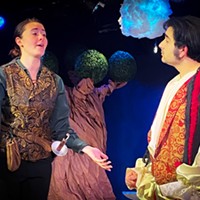
First Rate Twelfth Night
Apr 4, 2024 -
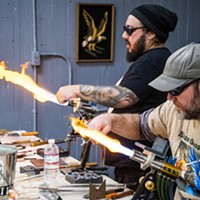
Photos: Humboldt Marble Weekend
Feb 14, 2024 -
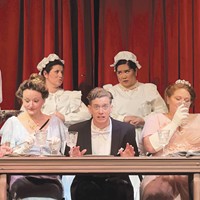
Gentleman's Guide to Love and Murder Slays
Feb 8, 2024 - More »
more from the author
-
SCOTUS on the Homeless, CPH Protest and Local Entertainment
- Apr 26, 2024
-
Look Up for Rooftop Sushi
- Apr 19, 2024
-
Resentencing, CASA Kids and Freaky Fish
- Apr 19, 2024
- More »
Latest in News
Readers also liked…
-
Through Mark Larson's Lens
A local photographer's favorite images of 2022 in Humboldt
- Jan 5, 2023
-
'To Celebrate Our Sovereignty'
Yurok Tribe to host gathering honoring 'ultimate river warrior' on the anniversary of the U.S. Supreme Court ruling that changed everything
- Jun 8, 2023
